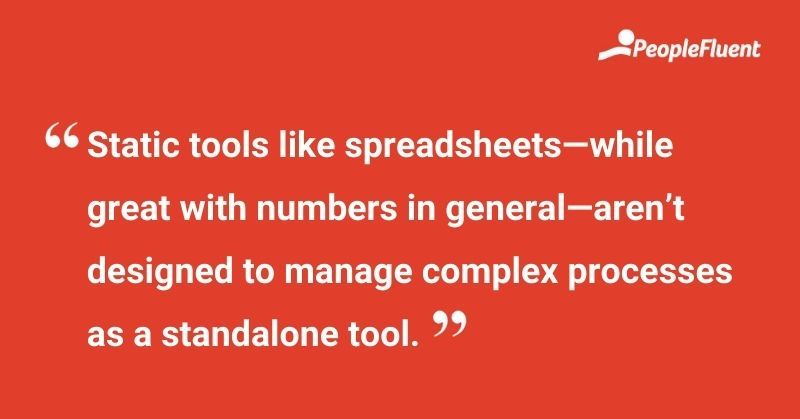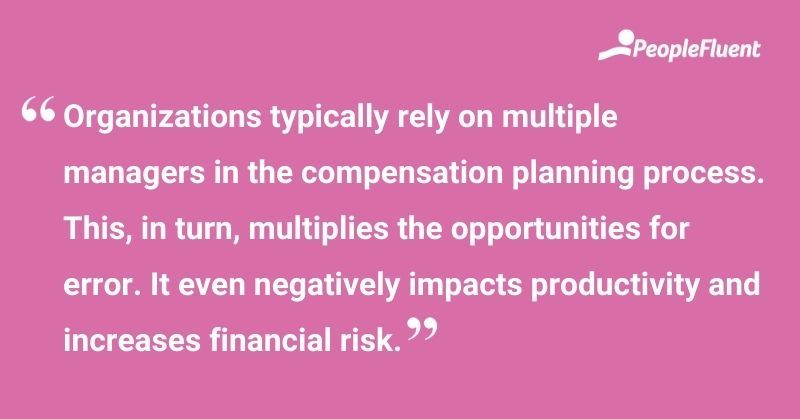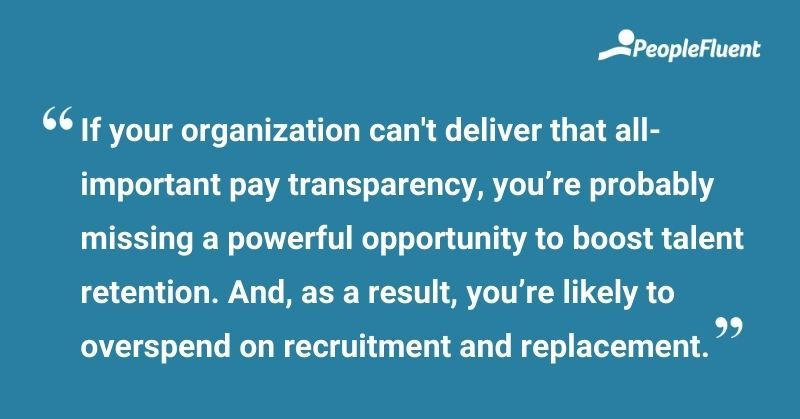Published: Aug 27, 2021Time to read: 8mins Category: Compensation
4 Dangers of Only Using Spreadsheet Templates for Compensation Planning
Spreadsheets can be a lifesaver for a lot of businesses. They’re a great tool for tracking, calculating, and charting various types of data. But, they aren’t a catch-all solution. HR pros and leaders have started to embrace automated tools for more complex processes such as compa-ratios, but there’s still work to do. If your company still relies heavily (or entirely!) on spreadsheet templates to manage compensation planning, keep reading.
Using spreadsheets to store, track, and manage your compensation spend seems logical, right? After all, it’s all about numbers. But, for a delicate process like compensation planning, spreadsheets lack the necessary functionality to create effective and reliable compensation programs.
And given the far-reaching impact of compensation on budgets and morale, you wouldn’t want to take unnecessary risks. It’s time to arm compensation and human resource professionals with the right tools. Like an automated compensation management tool to help them efficiently and strategically manage salaries, bonuses, and other types of compensation.
Ideally, the tool you use will also help strengthen the compensation management process holistically. Since the cost of labor is a large chunk of operating expenses, you can’t afford to get it wrong.
So, what are the risks associated with relying solely on spreadsheets for compensation planning? And what alternative solutions can you implement to avoid these dangers? Before we dive into the answers, let’s first establish the difference between compensation and compensation planning.

YOU MIGHT ALSO LIKE | ‘5 Benefits and Must-Have Features of a Compensation Solution’
What Is Compensation Planning?
In broad terms, compensation includes any form and combination of wages, salaries, and benefits that employees receive in exchange for their labor. In contrast, compensation planning is the process of charting and managing those components. That’s an important distinction because static tools like spreadsheets—while great with numbers in general—aren’t designed to manage complex processes as a standalone tool.
Spreadsheet templates are simply not efficient when used on their own. Especially when the goal is to manage compensation planning. Relying just on spreadsheets can result in major pitfalls such as:
- Expensive data entry errors
- Compliance and reputational risks
- Limited transparency that handicaps managers and demotivates employees
- Inefficient workflows that can’t scale
Let’s look at each one…
1. Expensive Data Entry Errors
There’s no question that human intervention increases the potential for error. People make mistakes—it’s bound to happen sometimes. Organizations typically rely on multiple managers in the compensation planning process. This, in turn, multiplies the opportunities for error. It even negatively impacts productivity and increases financial risk.
As each manager submits their version of the planning spreadsheet template, errors can creep in and compound. For example:
- Subtracting instead of adding
- Applying or changing formulas incorrectly
- Unknowingly making compensation decisions outside of set parameters
- Forgetting to include new employees
- Using the wrong version of the spreadsheet planning template
Now multiply these errors by hundreds of managers and your compensation team has some tough tasks ahead—for example, consolidating manager input, identifying errors, recalculating models, and following up with managers to fix the errors. It’s a lot of heavy lifting for one business function! And, it often results in decreased productivity as you’re taken away from daily tasks in order to manage the risk.
These errors can result in huge losses, too. For an enterprise organization of 20,000 employees, compensation planning errors could total in the hundreds of thousands—or even millions of dollars—in misspent funds. Cast your mind back to 1999 when NASA lost the Mars Climate Orbiter in space, a mistake due to human error that cost $125 million.

RELATED READING | ‘The Top 4 Benefits of Using Compensation Management Software’
2. Compliance and Reputational Risks
Unless your organization practices radical salary transparency, compensation data remains confidential.
With dozens or even hundreds of spreadsheets floating around the company—typically on laptops—the possibility for a security breach is high. What’s worse is that this reduced control over the data limits your ability to ensure compliance with industry, federal, state, and local mandates.
That’s why it’s important to make security and audit trail requirements a high priority throughout your compensation planning process. Both internal and external auditors demand process controls. These need to be well documented to demonstrate that they comply with security and policy rules.
Compliance risks from using spreadsheets include:
- Managers who don’t fully understand the template and make repeated errors, which OFCCP audits can expose
- Data dispersed across departments and systems makes it difficult to ensure and prove consistency across pay grades
When audits reveal problems like these, the repercussions can impact your employer brand and your organization’s bottom line.
ALSO READ | ‘3 Ways to Innovate and Improve Your Compensation Design Process’
3. Limited Transparency
The trend toward compensation transparency has continued to grow. Ultimately, your employees want to understand the rationale behind compensation decisions. It’s important for them to know the process that regulates their salary rates—and, to know how they compare with their peers. HR and business leaders recognize that pay transparency can boost employee motivation, collaboration, and performance.
If you’re using spreadsheets, full transparency just isn’t feasible. Especially since elements of the compensation process are dispersed throughout your organization, and the data isn’t centrally maintained.
We know companies typically compensate employees based on multiple factors—including performance, level of experience, education, skills, tenure, and market benchmarks. Without centralizing this data, the organization faces major challenges to:
- Empower managers with information they need to support meaningful and transparent conversations with their employees
- Provide employees with adequate context to understand compensation decisions
- Educate managers and improve their compensation decisions.
If your organization can't deliver that all-important pay transparency, you’re probably missing a powerful opportunity to boost talent retention. And, as a result, you’re likely to overspend on recruitment and replacement.

RELATED CONTENT | ‘The Real Cost of Pay Inequality: More Than Just $160 Trillion’
4. Cumbersome, Inefficient Workflows
Compensation planning requires input from numerous people, but there’s a problem with that: static spreadsheets can’t handle live updates from multiple contributors. The format requires either manually sharing a master copy from person to person or creating duplicates. Either way, it slows the process and opens the door to altered fields, botched formulas, and other errors. This isn’t a great case for efficiency!
And cloud-based spreadsheets can be just as problematic—from complex document permission settings, to multiple people changing cells at the same time, and even a simple ‘undo’ action which can cause accidental errors.
Compensation professionals need to analyze and sort data from many sources—both internal and external. This includes market data, survey data, and salary targets. Doing this with spreadsheets alone is cumbersome. The team cobbles data together, inputs it manually, sorts columns, and enters formulas to create the template—all with the knowledge that the hundreds of managers who receive it could mistakenly change key data and details.
So what does all this work add up to? On average, enterprise organizations with 15,000 employees spend as much as 8–12 weeks managing their compensation cycles using spreadsheets. A compensation management solution with agility and efficiency would cut the time and cost of only managing with spreadsheets.
HANDPICKED FOR YOU | ‘Driving DE&I With Compensation: How Analytics and Reporting Can Help’
Make The Shift From Spreadsheet Templates to Automation
Hopefully the perils of using spreadsheet templates for compensation planning will inspire your search for something better.
A true compensation management system—one designed specifically to manage the planning process—saves HR and comp teams considerable time. It also increases accuracy and enables:
- Real-time data analysis
- Visualization and modeling of budgets
- Advanced reporting for executives, managers, and HR
Beyond compensation planning, a true compensation management system can position your business to integrate other aspects of talent management. For instance, if you follow a pay-for-performance strategy, you can integrate the compensation and performance management systems to reap even greater value.

The Formula for Productivity
It’s clear that spreadsheet templates fall short of what’s needed to fully manage compensation planning. Given the business impacts at stake, there’s a clear and compelling business case for investing in a compensation management solution.
With the right solution in place, HR teams can shift from a tactical approach to more strategic efforts, including improving the quality of manager decisions about compensation and refining and communicating compensation strategy.
Beyond HR teams, the positive value of automated compensation management solutions will ripple across the organization in things like:
- Improved employee experience
- Optimized productivity
- Increased performance across the organization
Holistic compensation management is essential for any HR team that values engaging and retaining employees. And in doing so, you’re poised to get even greater value from your talent.
KEEP READING | ‘Why It's Time to Abandon the Merit Matrix’
Editor’s note: This blog post was originally published in 2018 and has been updated to reflect current trends.
Discover How to Reward People and Stay Competitive
PeopleFluent software provides the tools to help you plan and execute complex compensation plans, so you keep within your budget while attracting, rewarding, and retaining top performers.